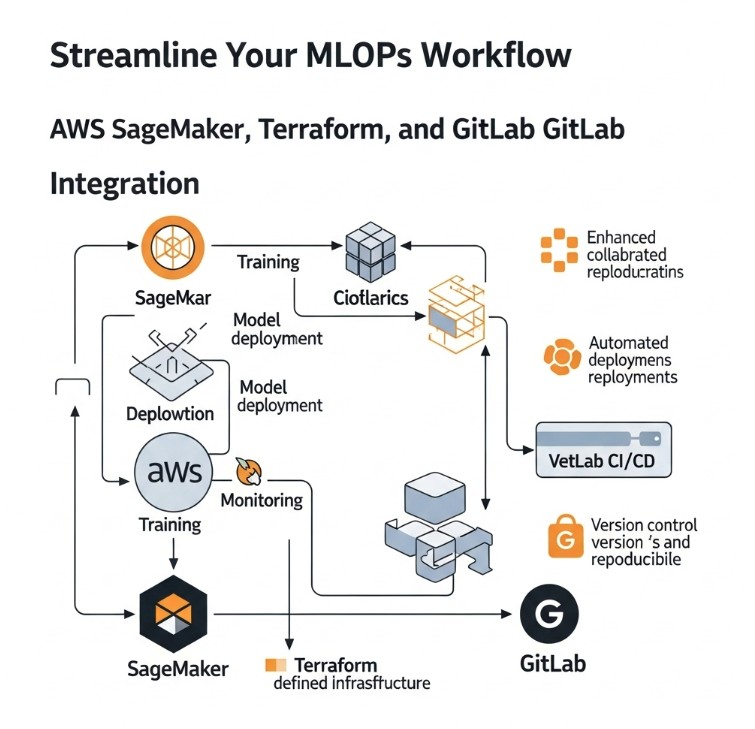Deploying and managing machine learning (ML) models in production is a complex undertaking. The challenges of reproducibility, scalability, and monitoring often lead to bottlenecks and delays. This is where MLOps comes in, providing a framework for streamlining the entire ML lifecycle. This article dives deep into building a robust MLOps pipeline leveraging the power of MLOps AWS SageMaker Terraform GitLab. We’ll explore how to integrate these powerful tools to automate your model deployment, infrastructure management, and version control, significantly improving efficiency and reducing operational overhead.
Table of Contents
Understanding the Components: AWS SageMaker, Terraform, and GitLab
Before delving into the integration, let’s briefly understand the individual components of our MLOps solution:
AWS SageMaker: Your ML Platform
Amazon SageMaker is a fully managed service that provides every tool needed for each step of the machine learning workflow. From data preparation and model training to deployment and monitoring, SageMaker simplifies the complexities of ML deployment. Its capabilities include:
- Built-in algorithms: Access pre-trained algorithms or bring your own.
- Scalable training environments: Train models efficiently on large datasets.
- Model deployment and hosting: Easily deploy models for real-time or batch predictions.
- Model monitoring and management: Track model performance and manage model versions.
Terraform: Infrastructure as Code (IaC)
Terraform is a popular Infrastructure as Code (IaC) tool that allows you to define and manage your infrastructure in a declarative manner. Using Terraform, you can automate the provisioning and configuration of AWS resources, including those required for your SageMaker deployments. This ensures consistency, repeatability, and simplifies infrastructure management.
GitLab: Version Control and CI/CD
GitLab serves as the central repository for your code, configuration files (including your Terraform code), and model artifacts. Its integrated CI/CD capabilities automate the build, testing, and deployment processes, further enhancing your MLOps workflow.
Building Your MLOps Pipeline with MLOps AWS SageMaker Terraform GitLab
Now, let’s outline the steps to create a comprehensive MLOps pipeline using these tools.
1. Setting up the Infrastructure with Terraform
Begin by defining your AWS infrastructure using Terraform. This will include:
- SageMaker Endpoint Configuration: Define the instance type and configuration for your SageMaker endpoint.
- IAM Roles: Create IAM roles with appropriate permissions for SageMaker to access other AWS services.
- S3 Buckets: Create S3 buckets to store your model artifacts, training data, and other relevant files.
Here’s a simplified example of a Terraform configuration for creating an S3 bucket:
resource "aws_s3_bucket" "sagemaker_bucket" {
bucket = "your-sagemaker-bucket-name"
acl = "private"
}
2. Model Training and Packaging
Train your ML model using SageMaker. You can utilize SageMaker’s built-in algorithms or bring your own custom algorithms. Once trained, package your model into a format suitable for deployment (e.g., a Docker container).
3. GitLab CI/CD for Automated Deployment
Configure your GitLab CI/CD pipeline to automate the deployment process. This pipeline will trigger upon code commits or merge requests.
- Build Stage: Build your Docker image containing the trained model.
- Test Stage: Run unit tests and integration tests to ensure model functionality.
- Deploy Stage: Use the AWS CLI or the SageMaker SDK to deploy your model to a SageMaker endpoint using the infrastructure defined by Terraform.
A simplified GitLab CI/CD configuration (`.gitlab-ci.yml`) might look like this:
stages:
- build
- test
- deploy
build_image:
stage: build
image: docker:latest
script:
- docker build -t my-model-image .
test_model:
stage: test
script:
- python -m unittest test_model.py
deploy_model:
stage: deploy
script:
- aws sagemaker create-model ...4. Monitoring and Model Management
Continuously monitor your deployed model’s performance using SageMaker Model Monitor. This helps identify issues and ensures the model remains accurate and effective.
MLOps AWS SageMaker Terraform GitLab: A Comprehensive Approach
This integrated approach using MLOps AWS SageMaker Terraform GitLab offers significant advantages:
- Automation: Automates every stage of the ML lifecycle, reducing manual effort and potential for errors.
- Reproducibility: Ensures consistent and repeatable deployments.
- Scalability: Easily scale your model deployments to meet growing demands.
- Version Control: Tracks changes to your code, infrastructure, and models.
- Collaboration: Facilitates collaboration among data scientists, engineers, and DevOps teams.
Frequently Asked Questions
Q1: What are the prerequisites for using this MLOps pipeline?
You’ll need an AWS account, a GitLab account, and familiarity with Docker, Terraform, and the AWS CLI or SageMaker SDK. Basic knowledge of Python and machine learning is also essential.
Q2: How can I handle model versioning within this setup?
GitLab’s version control capabilities track changes to your model code and configuration. SageMaker allows for managing multiple model versions, allowing rollback to previous versions if necessary. You can tag your models in GitLab and correlate them with the specific versions in SageMaker.
Q3: How do I integrate security best practices into this pipeline?
Implement robust security measures throughout the pipeline, including using secure IAM roles, encrypting data at rest and in transit, and regularly scanning for vulnerabilities. GitLab’s security features and AWS security best practices should be followed.
Q4: What are the costs associated with this MLOps setup?
Costs vary depending on your AWS usage, instance types chosen for SageMaker endpoints, and the storage used in S3. Refer to the AWS pricing calculator for detailed cost estimations. GitLab pricing also depends on your chosen plan.

Conclusion
Implementing a robust MLOps pipeline is crucial for successful ML deployment. By integrating MLOps AWS SageMaker Terraform GitLab, you gain a powerful and efficient solution that streamlines your workflow, enhances reproducibility, and improves scalability. Remember to carefully plan your infrastructure, implement comprehensive testing, and monitor your models continuously to ensure optimal performance. Mastering this integrated approach will significantly improve your team’s productivity and enable faster innovation in your machine learning projects. Effective use of MLOps AWS SageMaker Terraform GitLab sets you up for long-term success in the ever-evolving landscape of machine learning.
For more detailed information on SageMaker, refer to the official documentation: https://aws.amazon.com/sagemaker/ and for Terraform: https://www.terraform.io/. Thank you for reading the DevopsRoles page!
